How to Identify a White-Winged Dove
Updated: Mar. 08, 2024
Learn more about the white-winged dove, including what the bird looks like, what it eats, and where you can find one in North America.
On This Page
What Does a White-Winged Dove Look Like?
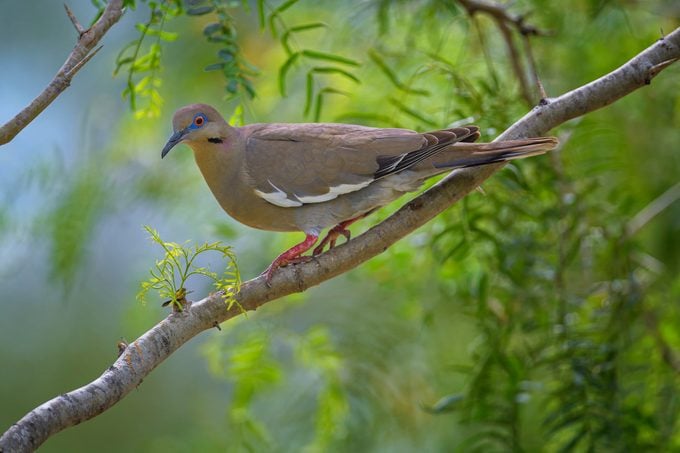
It can be tricky to tell doves apart. The white-winged dove is sometimes confused with the Eurasian collared-dove and mourning dove. They may have very similar grayish-brown coloring and are around the same size and shape. You can identify white-winged doves by their namesake white wing stripe.
Keith A. Arnold, Professor emeritus at Texas A&M University, says “Slightly smaller than a rock pigeon, white-wings have a white-tipped fan-shaped tail (brown in juveniles) and broad white wing patches, hence the common name.”
White-Winged Dove Calls and Sounds
Bird songs courtesy of the Cornell Lab of Ornithology.
According to the Kaufman Field Guide to Birds of North America, birders should listen for a rich cooing sound, described as “too soon to tell.”
Keith says the birds have a variety of calls, sometimes sounding much like a barred owl’s “who-cooks-for-you” call.
Do mourning dove feathers and wings make noise?
What Do White-Winged Doves Eat?
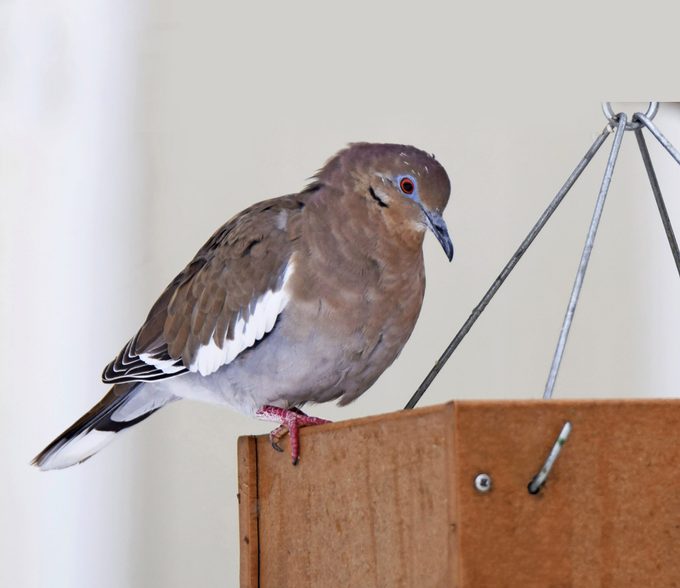
Keith says, “These doves are seed-eaters. (Where they eat) depends on what is available. They will feed in grain fields or weedy pastures and everything in between.”
This dove prefers a suburban habitat, but often moves into agricultural areas in flocks after breeding to forage in the fields.
If you live in their range, you might spot them at your backyard feeding station. “White-wings literally flock to feeders or, more accurately, grain spread on the ground,” says Keith. “I have had some doves learn how to use hanging feeders. They will eat standard bird seed mixes or grains like milo (grain sorghum).”
According to the Arizona-Sonora Desert museum, white-winged doves also eat sip nectar and eat cactus fruits (a source of water for the birds) in desert habitats.
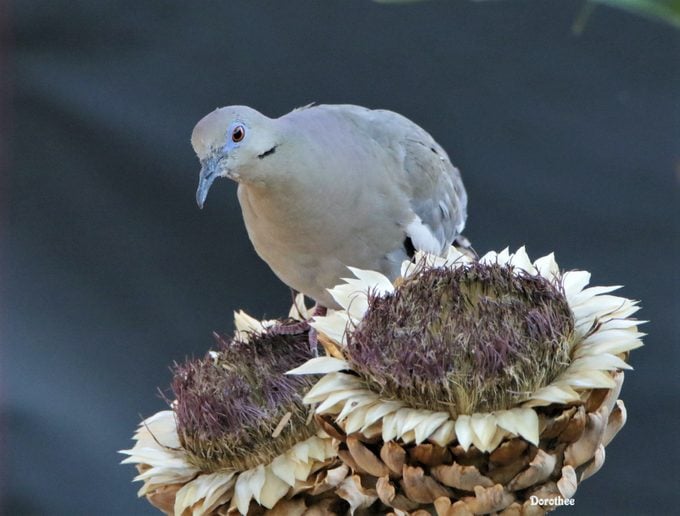
Birds and Blooms reader Dorothee Jeffers writes, “For the first time, I grew artichoke from seeds to attract wildlife to my backyard. This white-winged dove (above) landed on the dried up thistle heads looking for a snack.”
Mourning dove vs pigeon: what’s the difference?
White-Winged Dove Range and Migration
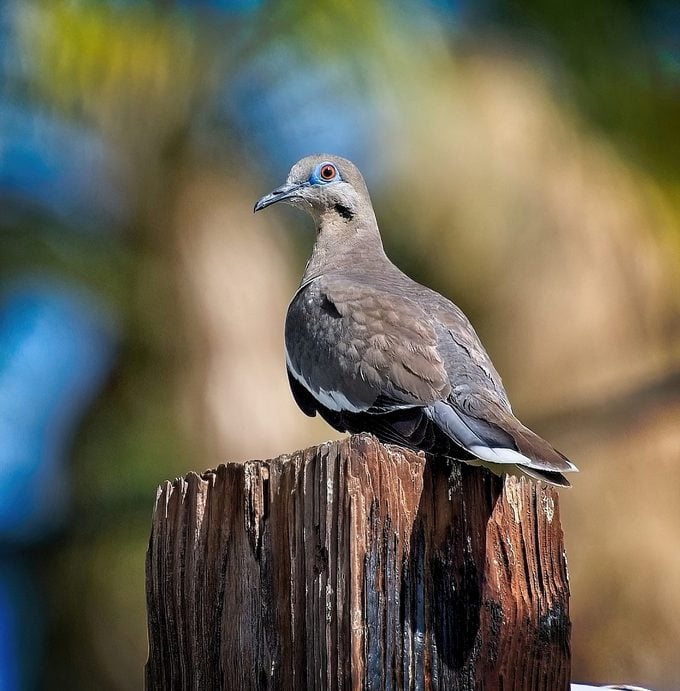
According to Keith, white-winged doves once were only found in south Florida, the Rio Grande Valley of Texas and southern Arizona. “In the 1980s, white-wings began to spread northward. Now these birds occur in the U.S. from Florida north to the mid-Atlantic states, across the Gulf and border states to the Great Lakes and across to the Pacific Northwest, absent from the Rocky Mountains and the north-central states.”
Some, but not all of these birds migrate. “White-winged doves are migratory in the northern portion of their range, but sedentary in the southern parts,” Keith says. “I do not know where this behavior might change, but I suspect that a broad area exists in which birds might migrate in some years, but not in others, depending on weather conditions.
Birding experts Kenn and Kimberly Kaufman say, “White-winged doves are related to mourning doves, but they’re mainly tropical and subtropical birds, common from the southwestern states and Florida, south to Central America and the Caribbean. They have been expanding their range northward in recent years in the Great Plains—they are now seen regularly in Oklahoma and Kansas. Wandering individuals have appeared a few times in most Canadian’ provinces, and even in Alaska.”
Did you know: Stevie Nicks’s famous song “Edge of Seventeen” opens with a white-winged dove. She says she was inspired after learning about the bird while traveling.
Is a turtledove a real type of bird?
Nesting Habits
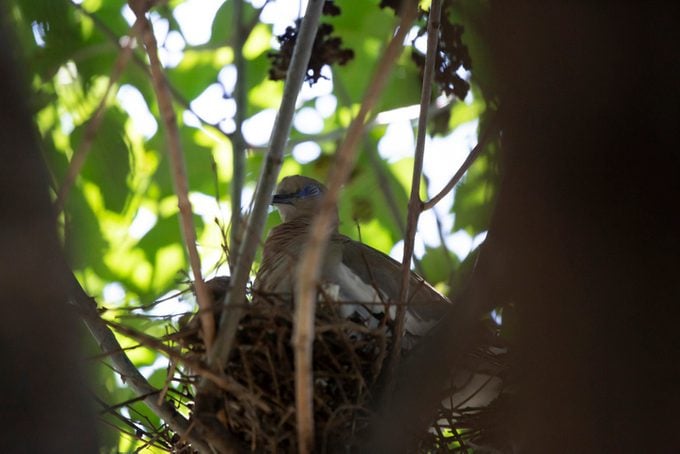
These doves nest in shrubs and tree, often in large colonies. The loosely woven nests are built of twigs, much like mourning doves. They lay two white eggs and may have several clutches in a season. White-winged doves also build their nests in cholla and saguaro cactuses, up to 30 feet high.
Keith says, “Given the high annual mortality of white-wings, it’s not surprising that these birds do not mate for life.” He explains, “This is a prime bird for hunters. Hunting is not a threat to these birds. At this time, I don’t see any concern for conservation.”
Next, learn more about the mourning dove lifespan: how long do doves live?
About the Experts
Keith A. Arnold is a Professor Emeritus with Texas A&M University. He taught ornithology for 39 years and had an active research program.
Kenn and Kimberly Kaufman are the official birding experts for Birds & Blooms. They are the creators of the Kaufman Field Guide series and they speak and lead birding trips around the world.
Sources
- Kaufman Field Guides
- Cornell Lab of Ornithology – white-winged dove
- National Audubon Society – white-winged dove
- Arizona-Sonora Desert Museum
- Americansongwriter.com
Why Trust Us
For nearly 30 years, Birds & Blooms, a Trusted Media Brand, has been inspiring readers to have a lifelong love of birding, gardening and nature. We are the #1 bird and garden magazine in North America and a trusted online resource for over 15 million outdoor enthusiasts annually. Our library of thousands of informative articles and how-tos has been written by trusted journalists and fact-checked by bird and garden experts for accuracy. In addition to our staff of experienced gardeners and bird-watchers, we hire individuals who have years of education and hands-on experience with birding, bird feeding, gardening, butterflies, bugs and more. Learn more about Birds & Blooms, our field editor program, and our submission guidelines.
Additional reporting by Kaitlin Stainbrook




















